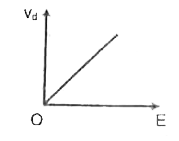if E denotes electric field in a uniform conductor and vd the corresponding drift velocity of free electrons in the conductor, then which of the following graph is correct




The correct Answer is:A
To solve the problem of determining the correct graph for the relationship between the drift velocity vd of free electrons in a conductor and the electric field E, we can follow these steps:
1. Understanding Drift Velocity:
The drift velocity vd of electrons in a conductor is given by the formula:
vd=IneA
where:
- I = current through the conductor,
- n = number of charge carriers (electrons) per unit volume,
- e = charge of an electron,
- A = cross-sectional area of the conductor.
2. Relating Current to Electric Field:
According to Ohm's law, the current I can also be expressed in terms of the electric field E:
I=VR
where V is the voltage across the conductor and R is the resistance.
3. Expressing Voltage in Terms of Electric Field:
The voltage V can be expressed as:
V=E⋅L
where L is the length of the conductor.
4. Finding Resistance:
The resistance R of the conductor is given by:
R=ρLA
where ρ is the resistivity of the material.
5. Substituting Values:
Substituting the expression for V and R into the equation for current I:
I=E⋅LρLA=E⋅Aρ
6. Substituting Current into Drift Velocity:
Now substituting I back into the drift velocity formula:
vd=IneA=E⋅AρneA
The area A cancels out:
vd=Eρne
7. Analyzing the Relationship:
From the final equation vd=Eρne, we can see that vd is directly proportional to E. This means that if we plot vd on the y-axis and E on the x-axis, we will get a straight line passing through the origin (0,0).
8. Conclusion:
Therefore, the correct graph representing the relationship between drift velocity vd and electric field E is a straight line that passes through the origin.
The drift velocity vd of electrons in a conductor is given by the formula:
vd=IneA
where:
- I = current through the conductor,
- n = number of charge carriers (electrons) per unit volume,
- e = charge of an electron,
- A = cross-sectional area of the conductor.
According to Ohm's law, the current I can also be expressed in terms of the electric field E:
I=VR
where V is the voltage across the conductor and R is the resistance.
The voltage V can be expressed as:
V=E⋅L
where L is the length of the conductor.
The resistance R of the conductor is given by:
R=ρLA
where ρ is the resistivity of the material.
Substituting the expression for V and R into the equation for current I:
I=E⋅LρLA=E⋅Aρ
Now substituting I back into the drift velocity formula:
vd=IneA=E⋅AρneA
The area A cancels out:
vd=Eρne
From the final equation vd=Eρne, we can see that vd is directly proportional to E. This means that if we plot vd on the y-axis and E on the x-axis, we will get a straight line passing through the origin (0,0).
Therefore, the correct graph representing the relationship between drift velocity vd and electric field E is a straight line that passes through the origin.
Topper's Solved these Questions
- CURRENT ELECTRICITYBook:FIITJEEChapter:CURRENT ELECTRICITYExercise:Exercise
Explore 9 Videos
- CURRENT ELECTRICITYBook:FIITJEEChapter:CURRENT ELECTRICITYExercise:Comprehension Based Type-1
Explore 3 Videos
- CURRENT ELECTRICITYBook:FIITJEEChapter:CURRENT ELECTRICITYExercise:SOLVED PROBLEMS (SUBJECTIVE)
Explore 10 Videos
- COLLISION Book:FIITJEEChapter:COLLISION Exercise:(NUMERICAL BASED QUESTIONS)
Explore 4 Videos
- ELASTICITY AND WAVES Book:FIITJEEChapter:ELASTICITY AND WAVES Exercise:Assignment Problems (Objective) Level-II
Explore 15 Videos
Similar Questions
Knowledge Check
If E is the electric field in uniform conductor, l is the current and Va and P denotes drift velocity and thermal power produced, then which of the following is correct:
A B
B C
C DBoth (a) and (b)
DBoth (a) and (b)Drift velocity of free electrons when current passes through the conductor is of the order of
A10mm/sB10m/sC10km/sD106m/sE denotes electric field in a uniform conductor, I corresponding current through it, vd velocity of electrons and P denotes thermal power produced in the conductor, then which of the following graph is incorrect?
A B
B C
C D
D
Derive an expression for drift velocity of electrons in a conductor. Hence deduce ohm's law.
View SolutionWhen current flows through a conductor, then the order of drift velocity of electrons will be
View SolutionThe average velocity of electrons in a conductor in the absence of electric field is
View SolutionThe drift velocity of electron in a metal conductor under effective of elecrtic field applied is
View SolutionWhen electric field inside a conductor is E, mobility of free electrons inside the conductor is μ. When the electric field is doubled mobility will be
View Solution